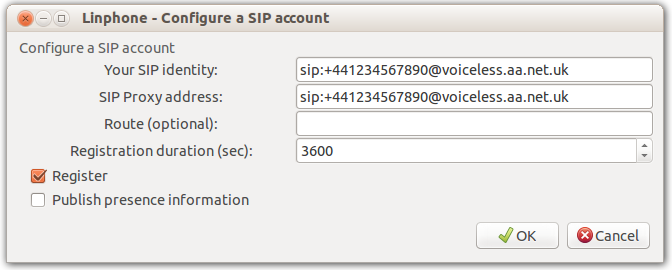VoIP Phones - Linphone
Linphone is a software phone from linphone.org for Linux, OS X, Windows and also mobile platforms (iPhone, Android and Blackberry)
| Feature Notes | |
|---|---|
| Tested on FireBrick SIP Server | Yes |
| IPv6 Support | Yes |
| Versions Tested | 3.5.2 (Ubuntu Linux)
4.1.1 (Android) |
Don't forget to tick the 'Use IPv6' tickbox!
OSX Config example (Sept 2020)
- Download Linphone, and drag to Applications, as usual with programs
- Open Linphone
- On startup, select 'USE A SIP ACCOUNT'
- Username: your phone number in +44 format
- SIP Domain: voiceless.aa.net.uk
- Password: Your SIP password
- Transport: UDP
- Good to go.
Android Config example (Sept 2020)
- Install Linphone from Play Store
- Open Linphone
- On startup, select 'USE A SIP ACCOUNT'
- Username: your phone number in +44 format
- Password: Your SIP password
- Domain: voiceless.aa.net.uk
- Transport: UDP
- Click login
- Good to go
iphone
Note: Some iPhone customers have reported problems with Linphone not able to receive calls if the iPhone is locked or if Linphone is not running in the foreground. This may may it unusable.
Notes
- Version 3 on Ubuntu Linux doesn't support srv records for direct sip calls. Version 4 on Android does.
- On Android, if you enable AVPF on an AAISP account then calls fail.
- It's reported that earlier version of Linphone can be tricky to setup, where as version 4.2 (and above) is very much "it just works" after going though the account setup.
Click to call
There was a discussion about using a web based CRM system and clickable telephone numbers, (e.g. using tel://03333400999) and making it work with linphone, as at the time it was not working for the end user.
On Windows, it was suggested that if you like importing random .reg files from the interwebs, there's https://gist.github.com/mekegi/7951345
Firewall & Security
- You will also want to set up firewall rules, as per the VoIP Firewall page.
- Also see the VoIP Security page for information about securing your VoIP service.
- Warning: VoIP passwords are stored as plain text in the config file (~/.linphonerc on Linux)

